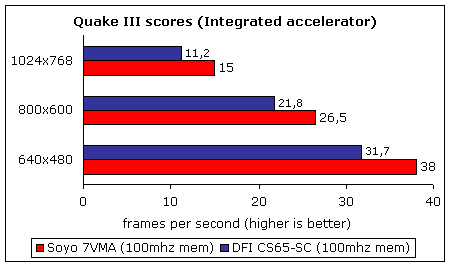We must keep in mind that Quake 3 is a very intensive game in terms of memory
bandwidth. Although the memory bus on our 7VMA was clocked 50% lower than the
DFI CS65 SC, it was only 10 15% slower.
Integrated Graphics
Performance
The Soyo 7VMA has an integrated
graphics accelerator based on the Savage 2000 2D engine and Savage4 3D core. Its
main rival, the i815 based boards, have an integrated graphics accelerator based
on the i752. The i752 is basically a newer version of the i740 accelerator
(which had its "fifteen minutes" a couple of years ago). All integrated
accelerators are usually based on unified memory architecture, meaning that the
system's main memory is shared both by the CPU and the graphics subsystem.
Naturally, memory bandwidth is also shared which degrades both system (to an
extent) and 3D performance.
Business
performance degradation when using the integrated accelerator instead of a
standard accelerator is quite small at low resolutions on low end processors
(like our reference Celeron 566MHz). If we use a faster processor (a PIII 700 or
better), then the 2D acceleration weakness of the integrated accelerator becomes
more obvious. Nevertheless the integrated 2D on the PM 133 is more than enough
for casual business applications. However, we did notice that the on board
accelerator did not support 32 bit color desktop on resolution 1280x1024 or
higher.
The integrated graphics accelerator found on all PM133 boards is
superior to any Intel 815/815E board. Even a low end processor can be held back
by the integrated 3D of an i815 board. Of course, all faster processors are held
back by the integrated 3D of the i752 even at very low resolutions due to the
poor triangle setup throughput. Hence, the i752 scales poorly with faster
processors. In addition, the i752 does not support texture compression thus poor
effective memory bandwidth becomes a major issue.On the other hand, the PM 133 found on the 7VMA seems to
scale much better with faster processors at low resolution. In fact, it can be
considered as a viable 3D solution for some very basic 3D gaming. The Savage4
integrated 3D engine is by far a better solution then the i752. It has a much
faster triangle setup, offers texture compression, better 3D quality and even 32
bit rendering. Because of these factors, the performance difference leans in
favour of the 7VMA on faster processors. The following chart clearly indicates
the same. On the following chart, we were able to get Soyo 7VMA scores with a
100MHz memory bus without stability problems. The scores are taken with sound
disabled.

Though it is nothing to boast about, it still beats 3D performance of another
integrated solution. Naturally, hardcore gamers do have the luxury of adding a
high end graphics accelerator and and when desired.
Sound
Quality
The Soyo 7VMA is equipped with a Sigmatel AC97 audio CODEC . This
CODEC does not support A3D or EAX but it sounds good enough for any low/medium
priced PC speakers. After listening to a number of tunes, I believe that most
users will be pleased with the audio CODEC on the 7VMA. Audio reproduction was
accurate and all frequencies ranging from bass to treble seemed to hit the mark.
Surprisingly enough, there is very little noise. We had to turn the volume
really high to begin hearing a bit of distortion. Of course, any audiophile or
serious gamer should use a sound card instead of the supplied AC97
CODEC.
